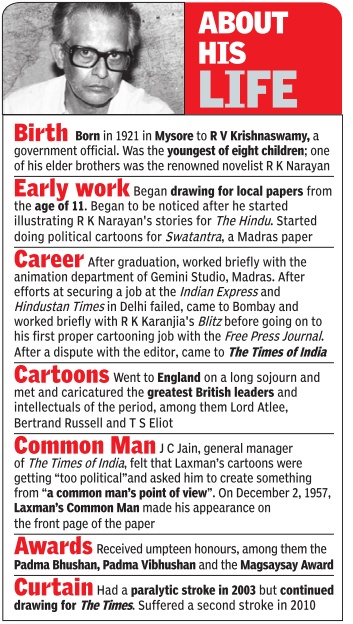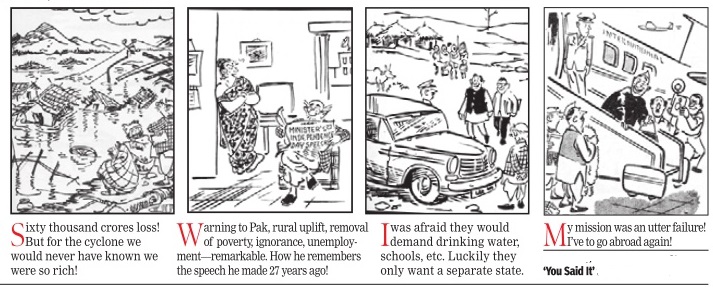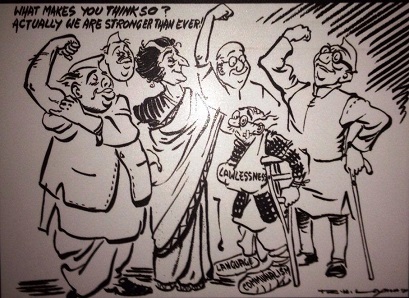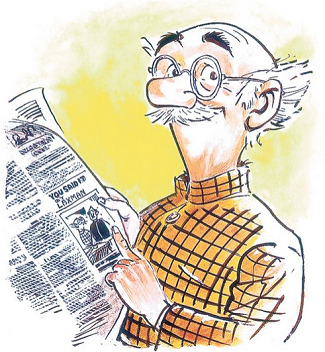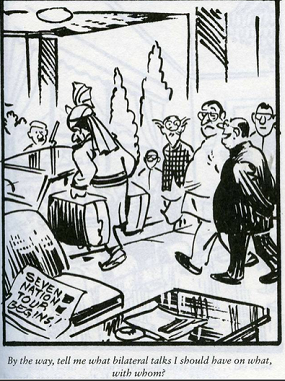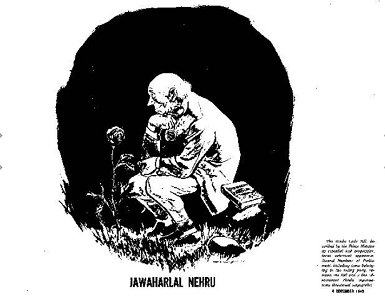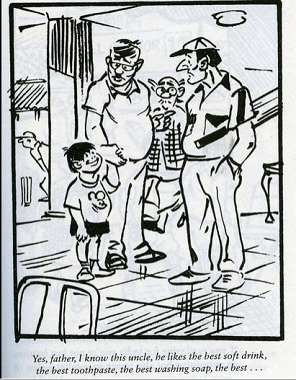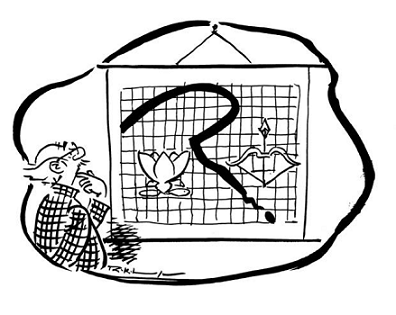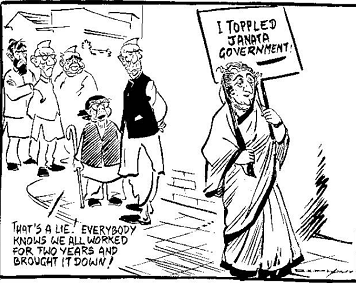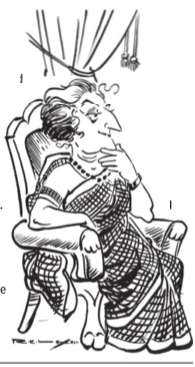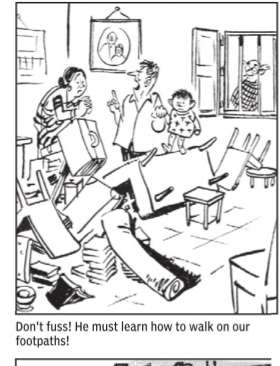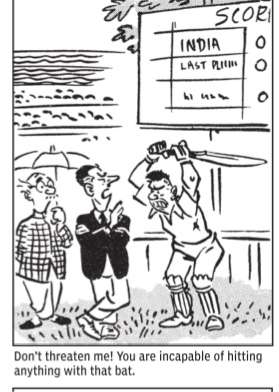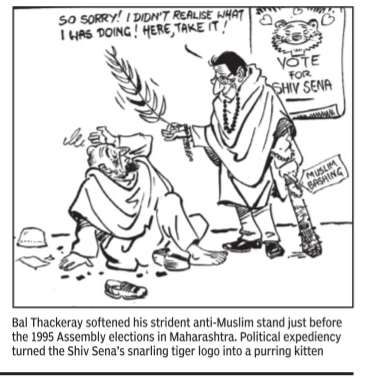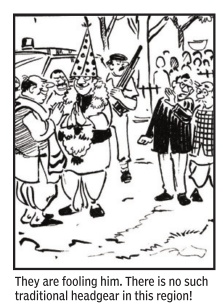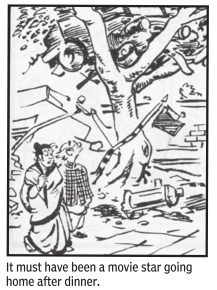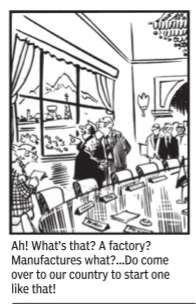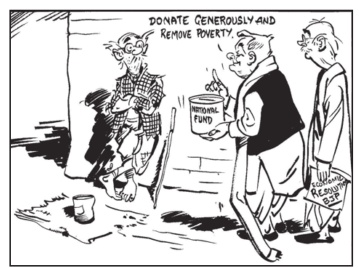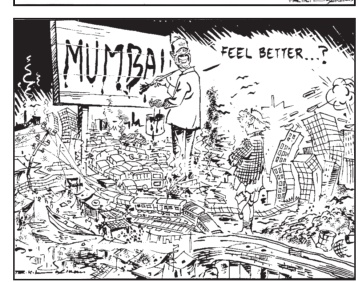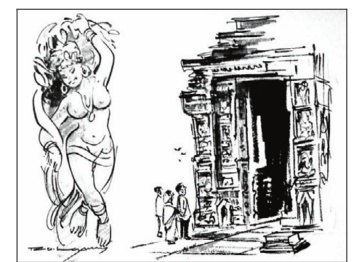R.K. Laxman
This is a collection of articles archived for the excellence of their content. |
The sources of the cartoons include...


Best of RK Laxman's cartoons
The Times of India
The man
R K Laxman, nation's uncrowned conscience keeper
Laxman, the youngest of six siblings, was born Oct 24, 1921, in Mysore. He showed promise very early in life. The illustrations in The Strand, Punch, Bystander and Tit-Bits, reputed British magazines, spurred his innate talent which found an outlet in his own house. He drew on its floor, walls and doors, sketched caricatures of his school teachers. Sir David Low, the world-famous cartoonist whose sketches also appeared in the Hindu, also influenced him.
R K Laxman, considered by many as one of the world's greatest cartoonists, was an institution unto himself, indisputably the uncrowned conscience keeper of the nation. No politician or minister, however high or mighty, escaped his pointed satire, conveyed through a few deft strokes of his brush, especially if they committed an act of impropriety or indiscretion.
Laxman's 'common man', who graced the front pages of The Times of India for more than five decades, under "You Said It" acquired an iconic stature of its own. These pocket cartoons not only conveyed the pulse of a nation, but also unfailingly delivered powerful messages. At the same time they mirrored the hopes and aspirations, follies and foibles of a society in transition.
The cartoons of Laxman became the defining moments in nation's history, as for instance, the one on Aryabhatta, India's first satellite. A couple of middle-aged office-goers are waiting at a bus stop. One of them wants to know the time. As soon as the other looks at his watch and answers, the questioner looks skywards, exclaims: "Aryabhatta must have completed one orbit by now."
His huge canvas spanned local, national and global personalities and issues, born out of his deep understanding of the cross currents shaping the world. His take on Angolan crisis in which both the super powers fought through proxies, at the height of the Cold War, shall remain among his many unforgettable cartoons.
The three-column illustration depicts Leonid Brezhnev and Jimmy Carter, presidents of erstwhile USSR and US, who are stealthily stepping across the coast of Angola, both armed and in the guise of burglars. Carter cries "thief-thief" as soon as he spots his burly opposite number. It exposes their double-speak and evokes laughter at the irony. These cartoons speak volumes about Laxman's capacity to convey complex geopolitical realities in his characteristic style.
Laxman's cartoons, undoubtedly the outcome of a brilliant mind, also entailed sheer hard work. It meant isolating himself for six hour daily, neither speaking nor listening to anyone during the period. "Searching for new ideas is an endless process. You have to come up with new and innovative idea each day," he said.
Some of the tomes showcasing Laxman's perspective also include the one which appeared just after the 1971 India-Pakistan war, in three columns, in his inimitable style. General Yayha Khan, pointing to the stack of destroyed Pakistani tanks and planes in the background, tells Zulfikar Ali Bhutto, with a smile: "Have I not made it seem like a thousand-year war," (which only lasted 14 days). Bhutto often boasted about waging a millennial war against India.
His work
Laxman immortalized passive, hapless common man
PTI | Jan 26, 2015 The Times of India
Capturing the entire gamut of idiosyncrasies of Indian politicians in an innocuous newspaper box with his cartoons, R K Laxman immortalized the passive, hapless common man with an uncanny perception and sarcasm in a daily commentary on his life that brought smiles to millions.
Every morning for over five decades, his fans waited for the 'common man' who, with his signature checked jacket, dhoti, Gandhi-glasses and twin tufts of gravity-defying hair, watched life and politics in India.
With his masterful strokes using the space of couple of inches, he exposed the hypocrisy in politics, leaving many a politician red-faced.
The son of a school teacher, Rasipuram Krishnaswamy Laxman, who rose to become India's best known political cartoonist, was born in Mysore on October 24, 1921. He was one of the seven siblings that included his elder brother eminent novelist R K Narayan.
With a penchant for drawing since his school days, Laxman was engrossed by the illustrations in magazines such as "Punch", " Tit-Bits", " Strand" and " Bystander" and came under an early influence of world renowned British cartoonist Sir David Low.
A creative genius, Laxman was known to have started doodling even before he could read, using floors, walls and doors of his house.
His artistic bent of mind was appreciated by a school teacher who noticed a drawing by him on a peepal leaf.
In his autobiography "The Tunnel of Time", the legendary cartoonist recalls, "I drew objects that caught my eye outside the widow of my room--- the dry twigs, leaves and lizard like creatures crawling about, the servant chopping firewood and of course, the number of crows in various postures on the rooftops of the buildings opposite?".
The crow was also a common figure in his cartoons later on.
Overcoming the setback in the death of his father, the young Laxman completed high school education and sought admission to Mumbai's J J School of Arts.
Ironically his application was rejected by the dean who remarked that his drawings "lacked the kind of talent required to qualify for enrolment in our institution as a student".
Laxman subsequently graduated with a Bachelor of Arts from University of Mysore even as he continued with freelancing and contributed cartoons to " Blitz", " Swarajya" and an animated film based on the mythological character of "Narada".
While at the Maharaja's College of Mysore, Laxman started illustrating R K Narayan's short stories in 'The Hindu' and also drawing political cartoons for local newspapers and a Kannada magazine devoted to humour titled " Koravanji", founded in 1942 by Dr M.Shivaram who encouraged the budding cartoonist. When he took up his first full time job as a political cartoonist at Mumbai's Free Press Journal, Laxman incidentally found himself in the company of Bal Thackeray who too worked in the same paper as a cartoonist for a brief period.
But his legendary spell on the Indian newspaper reader was cast after joining the Times Of India (TOI).
The comic strip "You said it" started in 1951, unleashing his iconic "common man", a silent witness to the shenanigans of politicians who were supposed to realise his dreams, hopes and aspirations but betrayed him on most occasions.
His association with TOI continued through the six decades even as he got back to work after recovering from a paralytic stroke in 2003 that incapacitated his left side.
A versatile artist, Laxman also wrote novels - Hotel Riviera and the Messenger, published by Penguin and contributed distinctive illustrations to many works including the "Malgudi Days" stories penned by his brother R K Narayan.
His autobiography in English "The Tunnel of Time' is translated into Marathi under title "Laxmanrekha". In a fitting tribute to the "Common Man" who attained a cult status, a commemorative postal stamp was issued featuring it in 1988 on the occasion of the 150th anniversary of TOI.
Among the honours bestowed on the cartoonist are B D Goenka award-Indian Express, Durga Ratan Gold medal - Hindustan Times, Padma Bhushan, Padma Vibhushan and the Magsaysay award in 1984 for Journalism, Literature and creative communication arts.
Laxman, married to author Kamala, later settled down at his Pune residence from where he continued his work. A 16 ft. bronze statue of the 'Common Man", sculpted by Vivek Khatavkar, was unveiled in the premises of the Symbiosis Institute here on December 19, 2001 in the presence of its creator.
Laxman’s targets
NO MORE LAXMAN REKHAS
Dileep Padgaonkar The Times of India Jan 27 2015
Lax man spared no one throughout his long career in the Times of India Group: potentates in the fields of politics, business, entertainment, sports, religion and the underworld. Day after day he enchanted his readers with his delightful irreverence to wards them. In the process he emerged as a sentinel occu pying a vantage point on the ramparts of our republic to safeguard it from harm.
What set him apart were two incomparable gifts. One was to portray the characteristic traits of a public figure with flawless accuracy . Every good caricaturist strives to project the distinctive physical features of such a figure.Laxman did that as well. But he did something more significant: through a facial expression, a pose or a gesture he sought to reveal, so to speak, his or her inner self. Many a cartoonist drew Nehru with his bald pate and a rose in the lapel of his jacket. But it was Laxman who depicted him as a patrician forever lost in his lofty thoughts. Indira Gandhi's hooked nose was the delight of all caricaturists.But the expression on her face drawn by Laxman--a hint of haughtiness--revealed with exceptional exactitude her character.
He achieved this feat with his caricature of every major politician: Morarji Desai with his permanent frown of righteousness, Krishna Menon's helter-skelter hairdo, Raj Narain's impish and slightly sinister smile, V .P. Singh's quizzical stare, Charan Singh's air of terminal smugness, Narasimha Rao's dowdy mien, Vajpayee's mischievous twinkle, Advani's aura of feigned invisibility... The list goes on and on from NTR to MGR, from Sonia Gandhi and Mayawati to Mamata Banerjee and Jayalalithaa, from Dilip Kumar to Amitabh Bachchan, not to mention the editors of this newspaper.
This satirical verve faltered only once. Laxman had a hard time caricaturing Rajiv Gandhi who was young, handsome and with no particular physical trait that would reveal his `inner self.' But to his relief, the youthful prime minister, who had raised so many expectations but had not quite been able to meet them, emerged as a Laxman caricature in person: rotund and a bit unhinged.
The other gift Laxman possessed was to whittle down complex issues to their bare essentials with a few bold strokes of the brush and a pithy caption. The squabbles, shenanigans and double-speak of the nation's movers and shakers enraged but also confused the citizenry .But Laxman peered right through this fog to spot what was at stake. More than most analysts he grasped what lay behind the words and deeds of those who claimed to serve the public weal.
The self-taught artist
R K LAXMAN| 1921-2015 - `NOTHING IN MY LIFE HAS BEEN INTENTIONAL, IT'S ALL ACCIDENT'
Radha Rajadhyaksha The Times of India Jan 27 2015
A self-taught artist, Laxman found his calling as early as three years of age, scribbling obsessively over the walls and floors of his Mysore house despite being “regularly spanked“ for it. As he grew older, his talent found an outlet in the local press, where he illustrated, among other things, the stories of his famous novelist brother R K Narayan. Keen on acquiring formal training, he applied to Mumbai's premier art institution, the J J School of Art, but was unceremoniously rejected on the ground that he “lacked the kind of talent to qualify for enrolment“. Laxman didn't particularly care about the snub then; however, decades later, he took great delight in pointing this out at a JJ function where he was invited to be chief guest.
As his magnificent career proved, the lack of academic training didn't turn out to be a stumbling block. Determined to make it as a cartoonist, Laxman left Mysore after his graduation, shuttling between cities and assignments till he landed his first full-fledged cartooning job with The Free Press Journal in Mumbai (from where his fellow cartoonist, Bal Thackeray , quit to pursue a more humourless path). After which happenstance and a buggy ride brought him to The Times of India in 1947.
In an interview with this writer in 1999, Laxman had outlined the narrative of his tryst with cartooning; how he had begun by accompanying his mother to the market square and sketching anything in sight--a cow chewing, a policeman on his beat, a vegetable seller. “From the beginning I was fascinated by human figures, the way they stand and sit, the way they lift someone else's hand to check the time and drop it,“ he'd said. Perhaps it was these exercises in capturing movement, somewhat different from the static model drawing then practised in art schools, that shaped the amazing fluidity of his cartoons in later years.
Laxman was philosophical, almost mystical, about the circumstances that had led him to don the mantle of India's best-known cartoonist. “Nothing in my life has been intentional,“ he'd told me.“It's all an accident. I was a humble philosophy-economics-politics student, studying autocracy-plutocracy-democracy; banking-currency-inflation; VedantaPlato-Socrates. Where did cartooning come in from? From the very beginning why did I take such an interest in the tree and how to draw and paint it? Nobody told me to. I used to cycle for miles with my sketchbook in Mysore, which was a very congenial place for an artistic fellow. If I'd been born in Bombay , I think I would have been on the Stock Exchange, Harshad Mehta maybe.“
The cartoonist, who'd sketch his teachers in class while the others struggled with arithmetic or grammar, had the gift, he claimed, of seeing a non-human form in every human. “What you see of the face is only a mask,“ he'd said. “Behind it is an animate object like a tiger or a crow. Sometimes it's also an inanimate object--some people look like broken-down trucks or old buildings. The possibilities are there but you can't see them unless you are slightly mad. You have to have extraordinary vision to see what is going on behind the face that is presented to society .“
This ability to perceive a non-human face lurking behind a façade, in combination, of course, with his childlike sense of mischief, is what made Laxman's drawings so delightful and also so unerring. Whether it was the distinctly bovine features of a Narasimha Rao, the eagle-like disdain of an Indira Gandhi, the hint of madness in the sundry politicians, sadhus and hangers-on of the '80s-'90s Hindutva brigade or the permanently fazed expression on the face of the Common Man, his caricatures unfailingly captured the essence of a personality . “The caricature is a totally different experience,“ he'd said. “It is the human face distorted without distorting the personality .“ Laxman revelled in this creative distortion--from his early caricatures of Hitler, Mussolini and Churchill (“I must be grateful to them for making me a political cartoonist“) to his series on global dignitaries like T S Eliot and Bertrand Russell to Indian film stars (old-timers recall his hugely popular series for Filmfare in the 1950s called `Stars I Never Met'), his brush inked almost every famous face in the world. And then, of course, there were India's politicians, his bread and butter (many, like Narasimha Rao and Laloo Prasad Yadav, he would say , were “created for a cartoonist“). Ironically, these targets of his swipes also admired him--if Nehru was a Laxman fan, politicians like Ar jun Singh and Jaswant Singh bought his original cartoons and felicitated him. “That's because politicians don't understand cartoons,“ he'd chuckled when I asked him about this paradox. However, while his fan following was huge, Laxman also had to face some criticism, mostly from younger, more deathly-earnest cartoonists who'd accuse him of being caught in a time warp and point out his failure to qualify as a “serious political commentator“, whatever that meant. Perhaps it was because his cartoons were more good-humoured than stinging, much like his brother R K Narayan's stories, which had earned him similar disapproval from the angry brigade. (Narayan's response to one such critic, who accused his stories of lacking political realism, was goodnatured: “Yes, there are no politicians in Malgudi. There is no traffic either.“) Laxman's response, when I asked him about this criticism, was one of exasperation. Launching a diatribe against the inherent futility of trying to strike intellectual postures in cartooning, he'd said, “See, if you have to comment on the budget, you comment in order to reach the common man, not the finance minister. The finance minister knows about it... it is the common man who has to be informed, in which case you have to make it understandable at the outset. Besides, the cartoon is a visual experience, not a written one--it must have more visual content than verbal comment. So if you want to make `serious political statements', for God's sake write, don't draw!“
In September 2003, after 56 years of a dream run came a blow that spelled the beginning of the end--Laxman suffered a stroke that rendered his left side paralysed. Although he refused to let his illness fell him, resuming drawing as soon as he was back from the hospital, a glimmer of sadness remained, often manifesting itself through tears at public felicitation functions. It intensified after his second stroke a few years later which robbed him of his speech, but he refused to let his grief come in the way of his cartooning. Urged on by his wife Kamala, he continued bravely till the very end, drawing his last publicly displayed cartoon in December 2014. Created in honour of the Mars Orbiting Mission, it depicted a jaunty Common Man, tricolour in hand, next to the Red Planet.
The feeble lines of the cartoon and of all Laxman's post-stroke work brought back poignant memories of the maestro's once-summary rejection of anything that was less than perfect in his work.Many years ago, he had requested an institute to return a brilliant-as-always sketch of the Common Man (done in five minutes at a public function) because a line on his thumb was “wrongly drawn“.In the interview I did with him, he'd suddenly got serious after much jesting when I asked him about the stress of producing two cartoons a day for years on end.
“Let me tell you one thing,“ he'd said. “Just because I have drawn for so many years it does not mean that I can just come into this room and dash off a cartoon. Every day is just like the first day; the agony, the pain. You cannot tell yourself, today I'm going to be first-rate, tomorrow secondrate because I'm tired. No. You may owe it to nobody else, but you owe it to yourself, to your conscience, to be consistently excellent. The predatory animal of Time is following you, and the Damocles sword of the deadline is hanging over your head but you cannot let down even for a minute.“
As a father, husband, son
He never brought work home: Wife
Ananya Dutta & Neha Madan The Times of India Jan 28 2015
He was a cartoonist of nationwide fame, but R K Laxman left work strictly at office, never discussing his cartoons with the family, recalled his wife Kamala Laxman.
Laxman's son, Srinivas recalled that the common man holding the tricolour on Mars was the last cartoon that his father drew. Srinivas said that he re ceived a special request from the Indian Space Research Organisation (Isro) for a cartoon to celebrate 100 days of the Mars Orbiter Mission (MOM). And Laxman obliged by drawing not one, but two cartoons in December 2014.
One of the earliest memories that Srinivas has of Laxman is his father dropping him off to school.
“On our way to school, he would describe to me everything he saw on the streets of Mumbai -people on the bus stop, schoolchildren, people waking up on the pavement, among other things. I still remember, we would chat with him at night while he sat with a drink. Those memories will remain etched in my mind forever,“ said Srinivas, who himself has made only one sketch in his life, when he was at Wolsingham School in Mumbai, and also won a prize for it.
Srinivas said that the legendary cartoonist never conformed to rituals.“One day, he received a phone call from his brother informing him of his mother's demise. She had passed away in Mysore.My father was immensely shaken with the news, but did not go to Mysore. He was very progressive; he did not observe rituals and was not a traditionalist,“ said Srinivas.
Random Sketches in Madhya Pradesh
Laxman's tryst with MP in `Random Sketches'
Partha Maitra & Ankur Sirothia The Times of India Jan 30 2015
Legendary cartoonist R K Laxman captured the natural magnificence of Madhya Pradesh when he was a state guest of then chief minister Arjun Singh in 1982-83. The exquisite sketches celebrated the timeless tapestries of nature bestowed on the state. This was collated into a 140-page book -`Madhya Pradesh, Random Sketches' --which Laxman wrote was “a few fleeting images left on the eye and not a tourist's guide book“.
Laxman found Pachmarhi more attractive than all other hill stations due to its profusion of waterfalls, pools and brooks and was particularly fascinated by the gentle Narmada weaving its way majestically between the tall marble rocks of Jabalpur.
In the book, Laxman wrote: “It will need more than a stub of pencil and a sketchpad to capture the sombre atmosphere that the Jahaz Mahal of Mandu is permanently wrapped up in or the mood of festivity that pervades the whole township of Omkareshwar...“
The RK brothers in Rushdie’s books
Rushdie and the Common Man Nina Martyris The Times of India Jan 28 2015
Rushdie's comic alter ego was modelled on Laxman's famous creation
Salman Rushdie, who grew up in Bombay on a daily fare of Laxman's pocket cartoon, mentions the Common Man in two of his books--his 1995 Mumbai novel The Moor's Last Sigh and his 2012 autobiography, Joseph Anton.
The Moor's Last Sigh features the Common Man in a unique way, by reproducing a tiny line sketch of his bemused face on Page 229. Written during the fatwa years, the novel is one of Rushdie's darkest books, but is enriched with allusions to famous Mumbai events and personalities. The Common Man reference occurs in a passage that describes a colourful moment in the city's cricketing history. During the 1960 India-Australia Test series, a young girl at Brabourne Stadium had spontaneously kissed the handsome batsman Abbas Ali Baig, causing All India Radio commentator Vijay Merchant to gripe, “I wonder where all these enterprising young ladies were when I was scoring my hundreds and two hundreds.“ In Rushdie's novel, the flamboyant artist Aurora Zogoiby reproduces the scene on canvas. But while the original kiss was nothing more than a chaste peck on the cheek, in Aurora's crowded painting, called The Kissing of Abbas Ali Baig, it is transformed into a luscious lip lock, a Khajuraho-level erotic embrace ogled by everyone around including “slavering politicians“, “coolly observant scientists“, wise-cracking industrialists, and the poor Common Man. Writes Rushdie: “Even the cartoonist R K Laxman's celebrated Common Man (sketch embedded here), was perched in the East Stand bleachers, looking shocked in his goofy, unworldly way .“
Laxman gave Rushdie special permission for the illustration to be reproduced. Incidentally, the novel also features a passage from R K Narayan’s novel Waiting for the Mahatma.
The Common Man pops up again in Rushdie’s memoirs, Joseph Anton. In the crazy aftermath of the Ayatollah’s fatwa, a dismayed Rushdie realized that he had more or less lost control of his name, that the word “Rushdie” had gone “spiraling off into the headlines“ and become a rallying point for support or abuse. As a sort of wry response, he created “a fragment of a character“, a comic alter ego called Ajeeb Mamouli. The oxymoronic name, meaning Mr Odd Ordinary or Mr Strange Normal, captured his own peculiar circumstances--an ordinary feller whose life had taken a viciously odd turn.
When Rushdie drew doodles of the imaginary Mamouli's face in his notebook, he found that “they looked like the famous Common Man created by the cartoonist R K Laxman in The Times of India: innocent, bemused, bald, with tufts of graying hair spraying out of his ears.“ Asked by Scotland Yard to suggest a fake name for himself for security purposes, Rushdie suggested Ajeeb Mamouli, but it was tur ned down for being “too Asian“ and too much of a mouthful. Ultimately, of course, he would choose an alias comprising the first names of two authors he admired, Joseph (Conrad) and Anton (Chekhov), which, in turn, would form the title of his memoirs.
Excerpts from Laxman’s autobiography
Honoured by Indira, banned by Morarji
The Times of India Jan 27 2015
A Padma Bhushan from the lady I kept making fun of!
A man who introduced himself as an official from the home ministry, New Delhi, said he had brought the good news that the PM had approved of the list of Padma Bhushan awardees and my name was included in it. I was stunned; here I was attacking and making fun of her in my cartoons, and she had seen fit to confer this honour on me! I suspected a catch in this somewhere!...I asked for a little more time to decide... Finally I agreed to accept the honour. The official announcement was made and congratulatory messages poured in from all parts of the country.
A circular from the home minister followed from Delhi, asking me to be present in the capital for rehearsals... If I was to bring my spouse I had to bear the expenses of her travel, and on the day of the function she should dress soberly, wearing a sari whose border should not be more than two inches broad! Fortunately I was spared the ordeal of attending the rehearsal as well as the ceremony as I had accepted an invitation to Germany at that time.Ten months later, the citation declaring that I was a Padma Bhushan and two medals--one big and another small--were delivered by a postman to my flat. There was a note from the home secretary stating that the big medal was to be worn for formal occasions and the small one on informal occasions. However, it hinted that neither should be displayed conspicuously.I am still to understand what these instructions meant.
TS Eliot snoozed as I sketched him
A couple of days later I was sitting with T S Eliot in his study. He uttered some obvious pleasantries but was mostly silent. As I began to make rough sketches of his tall figure, large nose and dreamy eyes, I told him about a poet I had met in London, who claimed that he knew Eliot so well that Eliot had written an introduction to a collection of that man's poems, currently in the press. When I mentioned the individual's name, Eliot raised his eyebrows and said he had neither heard of the poet nor had he written a foreword to any such book! Then he sat still, as if posing for an oil portrait. I made an elaborate pencil study of him. When I finished I held it out for him to autograph. He continued to sit without stirring. I had to clear my throat loudly, for he had gone to sleep. He woke up with a start and looked apologetic. He gazed at my drawing with amusement and signed it cheerfully.
The common man was a silent spectator
For a long time I believed I was providing the readers with some comic relief in their dreary humdrum existence. The bespectacled Common Man in his checked coat had walked into my cartoon spontaneously, as if I had no hand in his creation. Equally effortlessly he became a silent spectator of events, moving with ease from drought-stricken villages to the airport to watch foreign delegations arriving... Once he even visited the South Pole along with a minister for commerce who held bilateral talks with a group of attentive penguins.In the course of time I was surprised to discover that my readers looked upon me not merely as a cartoonist who tickled their sense of humour, but as a profound thinker, a social reformer, a political scientist, a critic of errant politicians and so on. I received letters complaining about postal delays, telephones, the sloppiness of municipal authorities, inflated electric bills, bribes in school admissions. One such letter pleaded, `Please halt the 47 Down train at ...... for a few minutes to save me the bother of waiting for four hours for the next one to go home from the office'.
Another offbeat incident revealed that my cartoons, besides provoking laughter, had a mystic appeal to a section of the public. In those days, betting on numbers was quite a popular pastime, though illegal. Gamblers somehow saw the possible lucky combinations of numbers in my cartoons. It went roughly along these lines --suppose there were four people in the cartoon on a particular day, with three looking one way and one the other way, that somehow provided sufficient clues for the gamblers to speculate accordingly... The number of lamp-posts, cars in a street scene, people in a bus queue were all indicators to where the treasure lay.
One morning, a fat fellow who looked like a trader, clad in an immaculate white kurta and dhoti with a gold chain adorning his neck, was waiting for my arrival at the office. He took out a sheaf of high denomination currency notes and offered it to me, asking in return for the favour of just one glimpse of the following morning's cartoon. This would help him to read the mysterious number hidden in it and thus gamble ahead of his rivals and make his fortune. It was not difficult to get rid of this customer. All I had to do was bring up imaginary legal objections to such a transaction, as specified in my contract as an employee of The Times of India. Before I could continue my narration to point out the illegality of betting, the chap had left the room and scooted away.
What on earth does this cartoon mean?
Wading through the sea of dog-eared sketches, I had to face another problem.Some of the cartoons made no sense at all.
N What in Heaven's name could they be referring s to? Perhaps they had brought national applause I on the day they were flashed on the front page of The Times of India. Perhaps the political clown shown in one cartoon was the chief minister of a minor state or a junior in the central cabinet, whose indiscretions and irresponsible pronouncements might have invited the attention of the whole nation, including mine, inspiring me to do the cartoon.The character must have since disappeared from the political scene; no trace of him existed now except the frayed drawing I was puzzling over! I was also nagged by the proliferation of acronyms. I had inscribed Congress (SDK), LB, KPSS, ABWU, OPPUWF and so on across the shirts of their leaders, on tattered flags, on tigers, pythons, bulls... It is in the nature of political cartoons to have a very short life except those few that satirize momentous national events.
Morarji Desai called a cabinet meeting to ban me
I congratulated myself on having achieved a harmonious routine--work, a couple of drinks in the evening at home in the company of my family and retiring early to read in bed. All this was shattered when Morarji Desai became the chief minister of Maharashtra and introduced prohibition to snuff out what he perceived as the evil habit of drinking. It was said he would not even drink plain water to quench his thirst, but would prepare his own 'recycled liquid' from within himself and consume that!Morarji Desai also banned horse racing and crossword puzzles.A cartoon I drew on this theme annoyed him so much that he held a full cabinet meeting to muzzle me and ban making the government, politicians and ministers objects of ridicule in the name of humour. He was told there was no way of stopping the cartoons since our Constitution fully protected the freedom of expression.
Rajiv began to resemble my cartoons of him
I knew Rajiv Gandhi would prove to be a difficult subject. He was tall, young and handsome.There was nothing in his physical features I could capture, exaggerate and exploit for my benefit. Besides... he had ideas that were lofty, progressive and of scientific temper. I was worried that if he succeeded, I would lose my job.
But soon my hopes revived... The Congress-I candidates for the Lok Sabha elections were found to be star actors, dancers, celebrity sportsmen and so on. I was able to gather plenty of ideas from Rajiv Gandhi's style of functioning. I even managed to find points in his features for distortion. I made him look a little more rotund than he really was, I shortened his nose and tilted it slightly upward. I thickened his eyebrows and reduced the hair on his pate, making him nearly bald. Thus, having remodelled him to suit my purpose, I began to produce this image day after day for the Times. Shortly, people started to remark that Rajiv had begun to resemble my cartoon version of him, losing his original God-given good looks!
`Did you draw this yourself, Laxman?'
He asked us to queue up and began to critically examine our efforts one by one, murmuring comments and giving marks. Sometimes he twisted a boy's ear or brought the cane down on the leg of another. When it was my turn he stared at the drawing for an alarmingly long time and asked me, “Did you draw it yourself, Laxman?“ I was frightened and stepped back, expecting a shower of blows. I replied, “You asked us to draw, Sir... I sat there and drew...“ fumbling for a safe excuse. But to my great surprise and joy, he held my slate up before the class and announced, “Attention! Look how nicely Laxman has drawn the leaf.“ He turned to me and said, “You will be an artist one day. Keep it up.“...I was inspired by this unexpected encouragement. I began to think of myself as an artist in the making, never doubting that this was my destiny.
Politicians like cartoons when...
As a rule I avoided meeting politicians. In my professional life I had learnt that when a politician congratulated me on my cartoon of the day and thumped me on the back saying I was a genius, he had just seen a nasty cartoon about his political enemy in the opposition or in his own party. On the other hand if a politician pumped my hand with warm and generous admiration for a cartoon in which I had ridiculed him, he was bound to start quietly telling me in a roundabout way that I lacked political judgement, and end up teaching me how to draw cartoons.
(Excerpted by The Times of India from 'The Tunnel Of Time' by R K Laxman, with permission from Penguin Books India)

